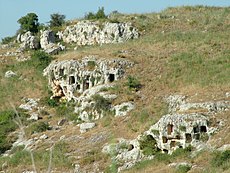Pantalica
| Syracuse and the Rocky Necropolis of Pantalica | |
|---|---|
| Name as inscribed on the World Heritage List | |
 |
|
| Location | Italy |
| Type | Cultural |
| Criteria | ii, iii, iv, vi |
| Reference | 1200 |
| UNESCO region | Europe and North America |
| Inscription history | |
| Inscription | 2005 (29th Session) |
The Necropolis of Pantalica in southeast Sicily, Italy, is a collection of cemeteries with rock-cut chamber tombs dating from the 7th to the 13th centuries BC. There have been thought to be over 5000 tombs, although the most recent estimate suggests a figure of just under 4000. They extend around the flanks of a large promontory located at the junction of the Anapo river with its tributary, the Calcinara, about 23 kilometres northwest of Syracuse. Together with the city of Syracuse, Pantalica was listed as a UNESCO World Heritage Site in 2005.
Pantalica is located on a limestone promontory surrounded by a deep gorge formed by the Anapo and Calcinara rivers between the towns of Ferla and Sortino in south-eastern Sicily. In addition to its archaeological interest it is an important nature reserve (Riserva Naturale Orientata Pantalica), with a variety of local flora and fauna and natural caves (notably the Grotta dei Pipistrelli (Bat Cave)). Various pathways facilitate visitor access, including a disused railway track (dismantled in 1956) along the Anapo valley bottom. The promontory can be accessed directly by car from Ferla, or by walking down the old mule track from the parking place on the road from Sortino and crossing over the Calcinara stream.
In the 13th century BC, some Sicilian coastal settlements were abandoned, possibly due to the arrival of the Sicels on the island and the onset of more unsettled conditions. New large sites, like Pantalica, appeared in the hilly coastal hinterlands, probably chosen for defensive reasons.
Pantalica evidently flourished for about 600 years, from about 1250 to 650 BC. The current name of the site probably dates from the Early Middle Ages or Arab period. The ancient name of the site is uncertain, but is associated by some archaeologists with Hybla, after a Sicel king named Hyblon, who is mentioned by Thucydides in connection with the foundation of the early Greek colony at Megara Hyblaea in the year 728 BC. For several centuries before Greek colonization, Pantalica was undoubtedly one of the main sites of eastern Sicily, dominating the surrounding territory, including subsidiary settlements. By about 650 BC, however, it seems to have been a victim of the expansion of the city of Syracuse, which established an outpost at Akrai (near Palazzolo Acreide) at this time. Nevertheless, it was still occupied during classical antiquity, since finds of the 4th-3rd centuries BC (Hellenistic period) are attested, as well as during the late antique or Byzantine periods. After the 12th century it was probably largely deserted, and overshadowed by Sortino.
...
Wikipedia
